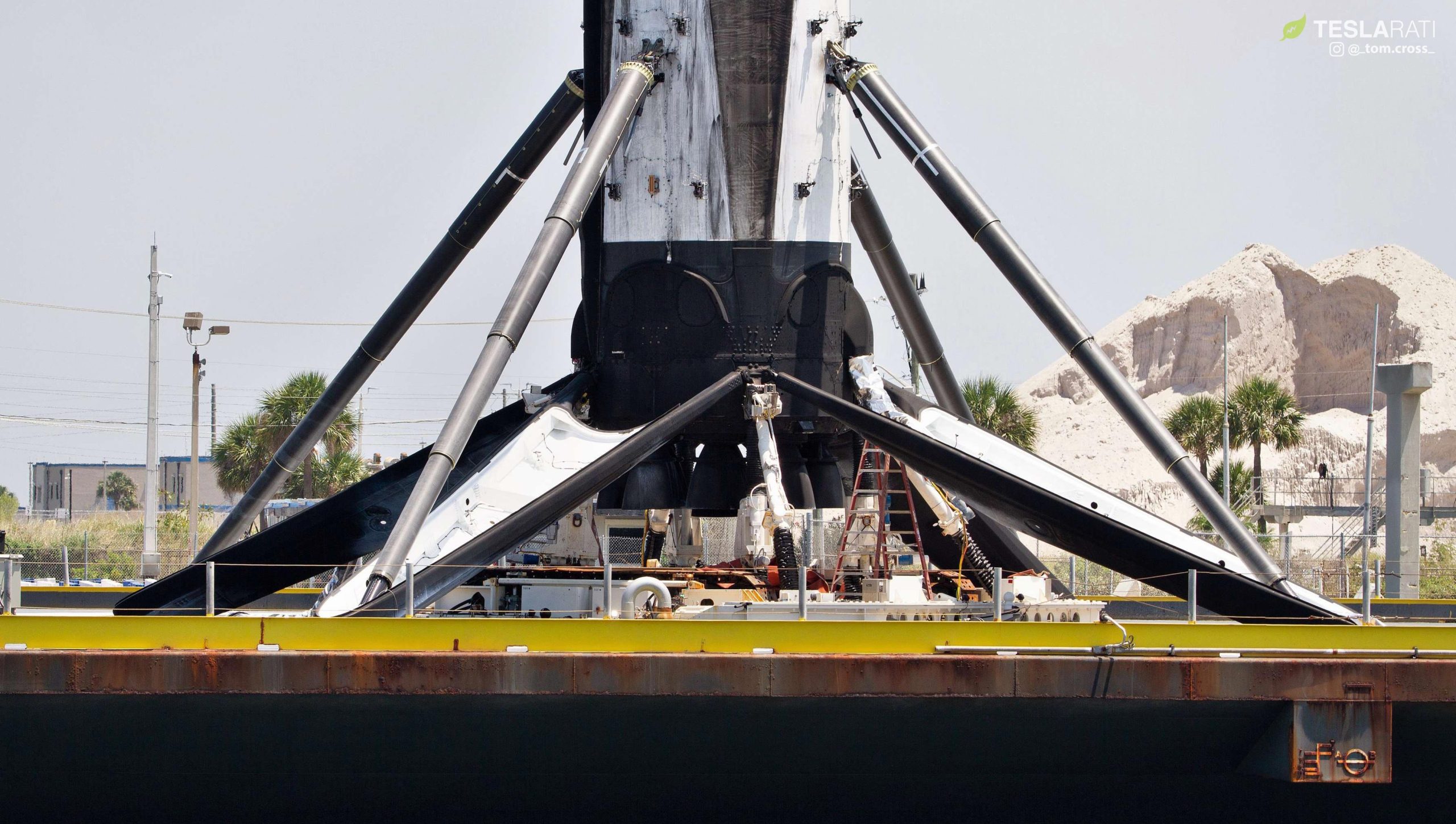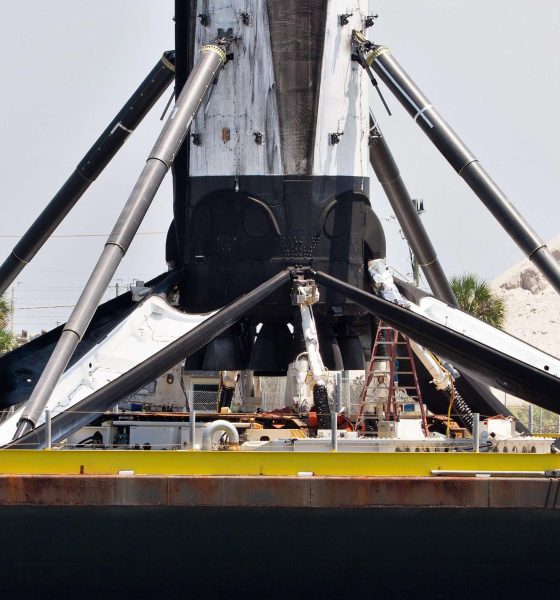

News
SpaceX beats Falcon 9 recovery records after company’s heaviest launch ever
Completed on May 30th, SpaceX’s latest Falcon 9 booster recovery smashed several internal speed records, unofficially cataloged over the years by watchful fans.
In short, as the company’s experienced recovery technicians continue to gain experience and grow familiar with Falcon 9 Block 5, the length of booster recoveries have consistently decreased in the 12 months since Block 5’s launch debut. Already, the efficiency of recovery processing has gotten to the point that – once SpaceX optimizes Block 5’s design for refurbishment-free reuse – there should be no logistical reason the company can’t fly the same booster twice in ~24-48 hours.
The road to rapid reusability
Rarely will it make headlines, but the fact remains that SpaceX’s ultimate goal is not just to reuse Falcon 9 (and other) boosters, but to do so with a level of routine efficiency approaching that of modern passenger aircraft. It’s reasonable to assume that chemical rockets might never reach those capabilities, but they may certainly be able to improve enough to radically change the relationship between humans and spaceflight.
Along that line of thinking, SpaceX CEO Elon Musk decided years ago that an excellent representative goal for Falcon 9 would be to launch the same booster twice in 24 hours. In the last year or so, that largely arbitrary target has changed a bit and is now believed to be a bit wider, aiming for booster reuse within a few days of recovery. This is a pragmatic adjustment more than a technical criticism of Falcon 9.
In general, Falcon 9 simply doesn’t have the performance necessary for routine reusability timelines measured in hours. The majority of SpaceX launches need enough of Falcon 9’s performance to necessitate recovery aboard one of SpaceX’s two drone ships, typically stationed at least a 200-300 km (100-200 mi) offshore. That fact alone almost single-handedly kills any chance of sub-24-hour booster reuse, given that the process of towing the booster-carrying drone ship back to port happens at a max speed of ~10 mph (15 km/h). Just gaining permission to enter the port itself often involves waits of 6+ hours a few miles offshore.
Low orbit, low mass Falcon 9 missions are much more promising for extremely rapid reusability, given that both of SpaceX’s West and East coast landing zones are located just a few miles (or less than 1500 feet, in the case of LZ-4) from their corresponding launch pads and processing facilities. However, these missions are quite rare, while SpaceX’s own low Earth orbit (LEO) Starlink launches will likely involve payloads so heavy that long-distance drone ship recoveries will be necessary.


Finally, there are Falcon Heavy launches, most of which will allow for both side boosters to return to the Florida coast for landings at LZ-1/LZ-2. However, these pose their own barriers to rapid reuse, mainly due to the fact that side boosters – while technically just Falcon 9 boosters – would need major changes to support a single-stack Falcon 9 launch. Falcon Heavy launches simply aren’t going to happen back-to-back over a period of 24-48 hours, so that option is also out of the question.
This means that SpaceX’s only real option for practical rapid reuse is to instead focus on something closer to a weekly launch capability for Block 5 boosters, meaning that the same booster would be able to launch, land, return to shore, and prepare for the next launch in the same week. Even then, launch site readiness may still stand in the way of truly radical improvements in booster reuse and launch frequency. After each launch, SpaceX’s pads and transporter/erectors take a significant beating, requiring routine repairs and maintenance before returning to flight-readiness. Barring major improvements, SpaceX has demonstrated minimum launch-to-launch times of roughly 10 days, and cutting that figure by 50-90% will be a major challenge for a rocket as powerful as Falcon 9.
B1049 takes a step forward
Despite the many logistical reasons that Falcon 9 will likely never lend itself to routine ~24-hour reusability, having that latent capability would still mean that the hardware is advanced enough to offer that efficiency. Even if SpaceX can’t literally fly each booster at its operational capacity, nearly refurbishment-free reflights will still translate into dramatically lower launch costs. Modern civilian aircraft need not fly every second of every day to still be affordable to operate (excluding amortization costs).
Ultimately, SpaceX has been taking small steps in that direction ever since the company began recovering (and reusing) Falcon 9 boosters. Falcon 9 B1049’s third recovery has been one of the best (and most record-breaking) steps yet, but those records were only just broken The most significant statistic to come out of the post-Starlink v0.9 recovery is that B1049.3 took less than 30 hours to go from docking in port to being horizontal on a SpaceX booster transporter. The previous record-holder was Falcon 9 B1046.2, requiring approximately 40 hours for the same feat. B1049.3 also holds the record for fastest recovery overall – just 48 hours from docking to being transported to a SpaceX hangar – but only beat B1051 by about half an hour. In general, Falcon 9 Block 5 has been privy to consistently quick recovery operations and B1049 is just the latest in a long line of reusable SpaceX rockets.



Check out Teslarati’s Marketplace! We offer Tesla accessories, including for the Tesla Cybertruck and Tesla Model 3.

News
Tesla FSD fleet is nearing 7 billion total miles, including 2.5 billion city miles
As can be seen on Tesla’s official FSD webpage, vehicles equipped with the system have now navigated over 6.99 billion miles.

Tesla’s Full Self-Driving (Supervised) fleet is closing in on almost 7 billion total miles driven, as per data posted by the company on its official FSD webpage.
These figures hint at the massive scale of data fueling Tesla’s rapid FSD improvements, which have been quite notable as of late.
FSD mileage milestones
As can be seen on Tesla’s official FSD webpage, vehicles equipped with the system have now navigated over 6.99 billion miles. Tesla owner and avid FSD tester Whole Mars Catalog also shared a screenshot indicating that from the nearly 7 billion miles traveled by the FSD fleet, more than 2.5 billion miles were driven inside cities.
City miles are particularly valuable for complex urban scenarios like unprotected turns, pedestrian interactions, and traffic lights. This is also the difference-maker for FSD, as only complex solutions, such as Waymo’s self-driving taxis, operate similarly on inner-city streets. And even then, incidents such as the San Francisco blackouts have proven challenging for sensor-rich vehicles like Waymos.
Tesla’s data edge
Tesla has a number of advantages in the autonomous vehicle sector, one of which is the size of its fleet and the number of vehicles training FSD on real-world roads. Tesla’s nearly 7 billion FSD miles then allow the company to roll out updates that make its vehicles behave like they are being driven by experienced drivers, even if they are operating on their own.
So notable are Tesla’s improvements to FSD that NVIDIA Director of Robotics Jim Fan, after experiencing FSD v14, noted that the system is the first AI that passes what he described as a “Physical Turing Test.”
“Despite knowing exactly how robot learning works, I still find it magical watching the steering wheel turn by itself. First it feels surreal, next it becomes routine. Then, like the smartphone, taking it away actively hurts. This is how humanity gets rewired and glued to god-like technologies,” Fan wrote in a post on X.
News
Tesla starts showing how FSD will change lives in Europe
Local officials tested the system on narrow country roads and were impressed by FSD’s smooth, human-like driving, with some calling the service a game-changer for everyday life in areas that are far from urban centers.

Tesla has launched Europe’s first public shuttle service using Full Self-Driving (Supervised) in the rural Eifelkreis Bitburg-Prüm region of Germany, demonstrating how the technology can restore independence and mobility for people who struggle with limited transport options.
Local officials tested the system on narrow country roads and were impressed by FSD’s smooth, human-like driving, with some calling the service a game-changer for everyday life in areas that are far from urban centers.
Officials see real impact on rural residents
Arzfeld Mayor Johannes Kuhl and District Administrator Andreas Kruppert personally tested the Tesla shuttle service. This allowed them to see just how well FSD navigated winding lanes and rural roads confidently. Kruppert said, “Autonomous driving sounds like science fiction to many, but we simply see here that it works totally well in rural regions too.” Kuhl, for his part, also noted that FSD “feels like a very experienced driver.”
The pilot complements the area’s “Citizen Bus” program, which provides on-demand rides for elderly residents who can no longer drive themselves. Tesla Europe shared a video of a demonstration of the service, highlighting how FSD gives people their freedom back, even in places where public transport is not as prevalent.
What the Ministry for Economic Affairs and Transport says
Rhineland-Palatinate’s Minister Daniela Schmitt supported the project, praising the collaboration that made this “first of its kind in Europe” possible. As per the ministry, the rural rollout for the service shows FSD’s potential beyond major cities, and it delivers tangible benefits like grocery runs, doctor visits, and social connections for isolated residents.
“Reliable and flexible mobility is especially vital in rural areas. With the launch of a shuttle service using self-driving vehicles (FSD supervised) by Tesla in the Eifelkreis Bitburg-Prüm, an innovative pilot project is now getting underway that complements local community bus services. It is the first project of its kind in Europe.
“The result is a real gain for rural mobility: greater accessibility, more flexibility and tangible benefits for everyday life. A strong signal for innovation, cooperation and future-oriented mobility beyond urban centers,” the ministry wrote in a LinkedIn post.
News
Tesla China quietly posts Robotaxi-related job listing
Tesla China is currently seeking a Low Voltage Electrical Engineer to work on circuit board design for the company’s autonomous vehicles.

Tesla has posted a new job listing in Shanghai explicitly tied to its Robotaxi program, fueling speculation that the company is preparing to launch its dedicated autonomous ride-hailing service in China.
As noted in the listing, Tesla China is currently seeking a Low Voltage Electrical Engineer to work on circuit board design for the company’s autonomous vehicles.
Robotaxi-specific role
The listing, which was shared on social media platform X by industry watcher @tslaming, suggested that Tesla China is looking to fill the role urgently. The job listing itself specifically mentions that the person hired for the role will be working on the Low Voltage Hardware team, which would design the circuit boards that would serve as the nervous system of the Robotaxi.
Key tasks for the role, as indicated in the job listing, include collaboration with PCB layout, firmware, mechanical, program management, and validation teams, among other responsibilities. The role is based in Shanghai.
China Robotaxi launch
China represents a massive potential market for robotaxis, with its dense urban centers and supportive policies in select cities. Tesla has limited permission to roll out FSD in the country, though despite this, its vehicles have been hailed as among the best in the market when it comes to autonomous features. So far, at least, it appears that China supports Tesla’s FSD and Robotaxi rollout.
This was hinted at in November, when Tesla brought the Cybercab to the 8th China International Import Expo (CIIE) in Shanghai, marking the first time that the autonomous two-seater was brought to the Asia-Pacific region. The vehicle, despite not having a release date in China, received a significant amount of interest among the event’s attendees.








